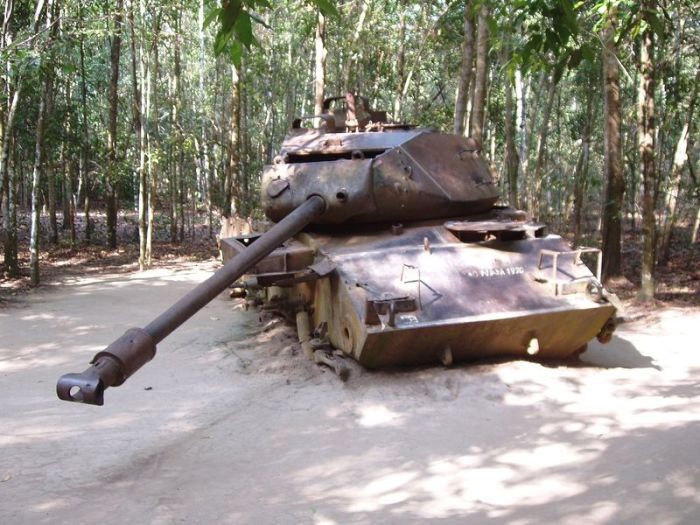|
|
Tunnels Of Củ Chi, Ho Chi Minh City, Saigon, Vietnam
|
The operation did not bring about the desired success as for instance on the occasion when troops found a tunnel, they would often underestimate its size. Rarely would anyone be sent in to search the tunnels, as it was so hazardous. The tunnels were often rigged with explosive booby traps or punji stake pits. The two main responses in dealing with a tunnel opening were to flush the entrance with gas, water or hot tar to force the Viet Cong soldiers into the open, or to toss a few grenades down the hole and “crimp” off the opening. The design of the tunnels along with the strategic use of trap doors and air filtration systems left the chosen approach to disable the Tunnel system completely, thus making them unusable thereafter, insufficient.
However, an Australian specialist engineering troop, 3 Field Troop, under the command of Captain Sandy MacGregor did venture into the tunnels which they searched exhaustively for four days, finding ammunition, radio equipment, medical supplies and food as well as signs of considerable Viet Cong presence. One of their number, Corporal Bob Bowtell died when he became trapped in a tunnel that turned out to be a dead end. However the Australians pressed on and revealed, for the first time, the immense military significance of the tunnels. At an International Press Conference in Saigon shortly after Operation Crimp, MacGregor referred to his men as Tunnel Ferrets. An American journalist, having never heard of ferrets, used the term Tunnel Rats and it stuck. Following his troop's discoveries in Cu Chi, Sandy MacGregor was awarded a Military Cross.
From its mistakes, and the Australians' discoveries, U.S. command realized that they needed a new way to approach the dilemma of the tunnels. A general order was issued by General Williamson, the Allied Forces Commander in South Vietnam, to all Allied forces that tunnels had to be properly searched whenever they were discovered. They began training an elite group of volunteers in the art of tunnel warfare, armed only with a gun, a knife, a flashlight and a piece of string. These specialists, commonly known as “tunnel rats”, would enter a tunnel by themselves and travel inch-by-inch cautiously looking ahead for booby traps or cornered PLAF. There was no real doctrine for this approach and despite some very hard work in some sectors of the Army and MACV (Military Assistance Command, Vietnam) to provide some sort of training and resources, this was primarily a new approach that the units trained, equipped and planned for themselves.
Despite this revamped effort at fighting the enemy on its own terms, U.S. operations remained insufficient at eliminating the tunnels completely. In 1967, General William Westmoreland tried launching a larger assault on Củ Chi and the Iron Triangle. Called Operation Cedar Falls, it was similar to the previous Operation Crimp, however on a larger scale with 30,000 troops instead of the 8,000.
|
|









